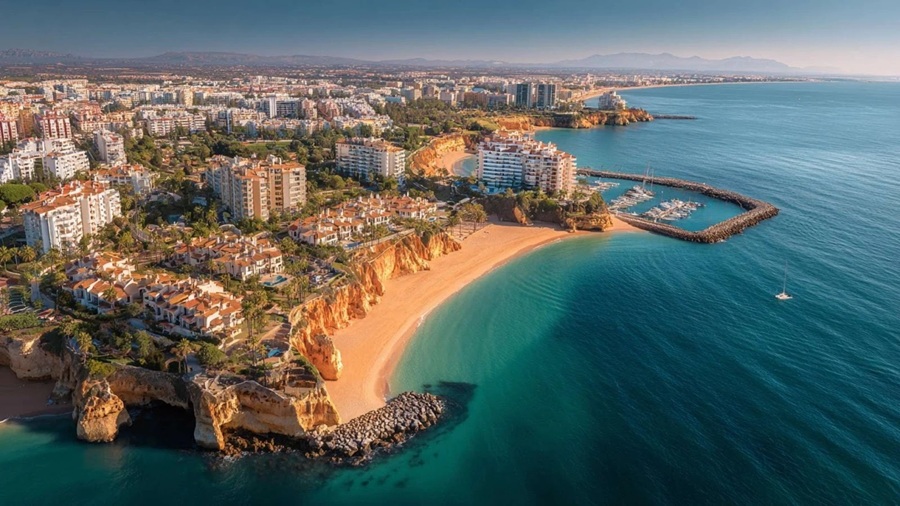2025 Real Estate Cost Portugal vs Spain : Which Market Offers Better Investment Value?

Published: 14.OCT.2025
The Iberian Peninsula continues to attract global investors, with Portugal vs Spain 2025 real estate cost emerging as a critical comparison for those seeking strategic property diversification in Europe. Both nations have shown resilience amid global economic uncertainty, supported by tourism, infrastructure development, and foreign capital inflows. However, evolving regulations, pricing dynamics, and rental performance in 2025 highlight important differences in long-term profitability and market accessibility.
This analysis aims to clarify which market currently offers better investment value — particularly for those looking to invest in property in Portugal. It reviews key metrics such as price per square meter, rental yields, and fiscal frameworks, providing a clear, data-backed perspective on where capital can achieve the best balance of growth, yield, and stability in the coming years.
Market Overview: Portugal and Spain in 2025

In 2025, both Portugal and Spain continue to consolidate their positions as key real estate investment destinations in Europe. Despite broader economic headwinds such as slower EU growth and tightening credit conditions, the Iberian real estate markets have proven resilient, supported by strong fundamentals: robust tourism, infrastructure expansion, and steady international demand. The comparison of Portugal vs Spain 2025 real estate cost reveals a notable divergence in market accessibility, yield performance, and investment stability.
Portugal (2025 Market Snapshot)
Portugal’s real estate market remains defined by stability, measured growth, and investor confidence.
● GDP growth forecast (IMF 2025): +1.8%
● Inflation rate: 2.2%
● Average residential price: €3,350/m² (Confidencial Imobiliário, Q1 2025)
● Average commercial property price: €2,450/m²
● Rental yield range: 5.0–6.5% (residential), 6–7.5% (commercial)
● Tourism arrivals: +10% YoY, exceeding 30 million visitors (INE Portugal)
The country’s market continues to benefit from a controlled supply pipeline and strong foreign investor participation, particularly from the EU, UK, and North America. Lisbon and Porto lead in transaction volumes, while secondary cities such as Braga and Évora attract attention due to affordable entry costs and higher yields. The updated Golden Visa program, refocused on commercial and urban regeneration projects, further supports institutional-grade investments.
Spain (2025 Market Snapshot)
Spain remains Europe’s fourth-largest property market by transaction value, yet its structure reflects more cyclical tendencies.
● GDP growth forecast (IMF 2025): +1.9%
● Inflation rate: 2.6%
● Average residential price: €3,850/m² (Idealista, Jan 2025)
● Average commercial property price: €3,100/m²
● Rental yield range: 4.0–5.5%
● Tourism arrivals: +8% YoY, reaching 85 million visitors (INE Spain)
Spanish cities such as Madrid and Barcelona continue to attract institutional investors due to scale and liquidity, but pricing in these markets remains significantly higher than in comparable Portuguese regions. Additionally, rising construction and financing costs have begun to constrain new project pipelines, particularly in high-demand areas like the Costa del Sol and Balearic Islands.
While both countries demonstrate solid fundamentals, Portugal offers a more favorable balance between property cost, rental yield, and long-term value growth. Spain’s larger scale provides liquidity, but its higher entry costs and cyclical volatility position Portugal as the more stable environment for investors seeking consistent returns and manageable risk exposure. For those planning to invest in property in Portugal, 2025 presents a strong window to secure competitive assets before further appreciation narrows the current pricing advantage.
Price Comparison by Region

The regional breakdown of the Portugal vs Spain 2025 real estate cost highlights structural differences in market composition and pricing. While both countries share Mediterranean demand drivers—tourism, limited supply, and investor-friendly legislation—the entry thresholds, yield potential, and pace of appreciation vary significantly between regions. Understanding these regional nuances is essential for investors comparing Portugal vs Spain property prices 2025 and evaluating long-term return potential.
Portugal: Competitive Pricing and Yield Balance
Portugal’s property market demonstrates strong regional diversity, offering investors a wide range of cost-to-return ratios.
● Lisbon: The capital remains the country’s prime market, with average prices around €5,000/m² and annual growth of +4.1%. Commercial zones, particularly Parque das Nações and Marquês de Pombal, show yields near 5.2%, sustained by office demand and tourism-linked retail.
● Porto: Known for dynamic rental demand and university-driven growth, Porto averages €3,600/m² with yields of 5.8%, reflecting high occupancy and limited supply.
● Algarve: A mature resort market with strong tourism fundamentals. Average prices stand near €4,200/m², with 6.0% yields—among the highest in Portugal’s coastal regions.
● Braga and Northern Regions: Emerging investment zones with affordable entry points (~€2,400/m²) and yields exceeding 6.3%. Increasing logistics activity enhances commercial opportunities.
Spain: Higher Entry Costs and Mature Markets
Spain’s major cities remain more expensive, with higher transaction volumes but lower yield margins.
● Madrid: The capital’s property values average €5,800/m² and offer 4.2% yields, reflecting tight supply but slower growth (+2.9% YoY).
● Barcelona: Prices are similar at €5,900/m², though regulatory constraints on short-term rentals have limited investor returns (4.1% yield).
● Valencia: An increasingly popular secondary market, averaging €3,400/m² and 4.8% yields.
● Costa del Sol: Driven by tourism, this region averages €4,700/m² and yields of 4.6%, though local oversupply risks persist.
Region |
Country |
Avg. Price €/m² (2025) |
Rental Yield |
YoY Change |
Lisbon |
Portugal |
€5,000 |
5.2% |
+4.1% |
Porto |
Portugal |
€3,600 |
5.8% |
+3.8% |
Algarve |
Portugal |
€4,200 |
6.0% |
+4.5% |
Braga |
Portugal |
€2,400 |
6.3% |
+5.0% |
Madrid |
Spain |
€5,800 |
4.2% |
+2.9% |
Barcelona |
Spain |
€5,900 |
4.1% |
+2.5% |
Valencia |
Spain |
€3,400 |
4.8% |
+3.2% |
Costa del Sol |
Spain |
€4,700 |
4.6% |
+3.7% |
Comparative Insight
The cost per square meter Portugal Spain comparison reveals a consistent 15–25% pricing gap in favor of Portugal across both residential and commercial assets. While Spain provides larger transaction volumes and deeper liquidity, Portugal delivers superior yield efficiency and lower acquisition costs, particularly attractive to mid-sized private and institutional investors.
As 2025 progresses, analysts anticipate that Portugal’s regional markets — especially Porto and the Algarve — will outperform Spain’s coastal counterparts in total return potential. For investors planning to invest in property in Portugal 2025, current regional pricing still offers a favorable entry window before the next upward adjustment cycle.
Investment Climate and Regulation

The investment environment plays a decisive role when comparing the Portugal vs Spain 2025 real estate cost. Both markets remain open and transparent for foreign investors, yet their fiscal frameworks, administrative procedures, and incentive programs differ in efficiency and predictability. These factors significantly influence long-term returns and ease of operation, particularly for commercial property investors.
Portugal: Transparent and Investor-Friendly Framework
Portugal maintains a stable and efficient regulatory system that supports both domestic and international investment.
● Property transfer tax (IMT): 5–7.5%, depending on asset type and value.
● Annual property tax (IMI): 0.3–0.45%, below most EU averages.
● Capital gains tax: 28% for non-residents, with deductions available for reinvestment.
● Corporate tax: 21% standard, reduced rates in Madeira and other development zones.
● Golden Visa (2024 revision): Now focused exclusively on commercial and urban rehabilitation investments, encouraging sustainable and business-oriented development.
Portugal’s legal structure ensures full foreign ownership rights and streamlined registration procedures. Combined with political stability and EU membership, this makes the country an attractive base for investors seeking predictable regulatory conditions and reliable capital protection.
Spain: Larger Market, Higher Complexity
Spain offers scale but a more fragmented fiscal landscape across its autonomous regions.
● Property transfer tax (ITP): 6–10%, depending on location.
● Annual property tax (IBI): 0.4–1.1%.
● Capital gains tax: 19–26%.
● Corporate tax: 25%.
● Golden Visa: Still applies to residential purchases over €500,000, though policy changes are under review.
While Spain’s market depth appeals to institutional investors, complex regional taxation and stricter rental regulations create administrative challenges.
For investors evaluating the Iberian real estate comparison, Portugal offers a more streamlined, tax-efficient, and transparent framework. Combined with a focus on commercial investment incentives, it provides an environment better aligned with long-term, risk-managed real estate strategies.
Rental Yields and Return Potential
Comparing Portugal vs Spain 2025 real estate cost also requires assessing the rental yield differential, as it directly reflects income potential and capital efficiency. Portugal continues to outperform Spain in both residential and commercial property returns, supported by high occupancy, stable tourism, and disciplined new construction.
Portugal: High Yields and Strong Demand Drivers
● Residential yield range: 5.0–6.5%, above most Western European averages.
● Commercial yield range: 6.0–7.5%, particularly strong in logistics and hospitality assets.
● Key markets: Lisbon and Porto show consistent corporate rental demand, while Algarve tourism ensures steady seasonal occupancy.
● Investor focus: Urban regeneration projects and serviced apartments remain top-performing sectors.
Spain: Moderate Returns and Regional Variability
● Residential yield range: 4.0–5.5%.
● Commercial yield range: 5.0–6.0%, with Madrid and Barcelona offering stability but limited growth.
● Tourism markets like Costa del Sol and Valencia maintain solid rental activity but face oversupply pressures in certain subsegments.
On a yield-adjusted basis, Portugal delivers 1–1.5% higher net returns than Spain while maintaining lower acquisition costs and operational risk. This makes it a more balanced environment for investors seeking long-term income growth and sustainable capital appreciation in 2025.
Risks and Market Stability
Any comparison of Portugal vs Spain must also consider macroeconomic and regulatory risks. Both countries show resilience, but their stability profiles differ in consistency and exposure to cyclical pressures.
Risk Factor |
Portugal |
Spain |
Economic volatility |
Low |
Moderate |
Oversupply risk |
Low |
Medium |
Regulatory uncertainty |
Moderate |
High |
Price correction probability |
Low |
Moderate |
Political stability |
High |
Moderate |
Key Observations
● Portugal maintains limited construction activity and prudent lending, reducing exposure to speculative cycles.
● Spain faces higher regional policy variation and tighter rental regulations.
● Both remain politically stable within the EU framework, but Portugal’s smaller, well-regulated market provides greater predictability for long-term investors.
Overall, Portugal offers a more controlled and transparent investment climate, ideal for those seeking steady, risk-adjusted returns in the Iberian property market.
Outlook for 2025 and Beyond

Looking ahead, the Portugal vs Spain real estate outlook reflects diverging trends in growth and resilience. Both nations are expected to sustain moderate appreciation, but Portugal shows stronger fundamentals and a healthier yield-to-price balance.
Forecast Highlights
● Portugal: Anticipated 3–5% annual price growth driven by limited supply and strong foreign demand.
● Spain: Projected 2–3% annual growth, with performance varying sharply between regions.
● Commercial sector: Logistics, hospitality, and mixed-use assets expected to outperform in both countries, with Portugal offering higher yield margins.
Portugal’s measured expansion, transparent governance, and cost advantage support its reputation as a stable, yield-driven alternative in the Iberian real estate landscape, particularly appealing to investors pursuing long-term portfolio diversification.
Conclusion: Why Portugal Holds the Competitive Edge
The comparison of Portugal vs Spain real estate reveals two mature but contrasting markets. Spain continues to offer scale and liquidity, yet its higher entry barriers, regulatory complexity, and lower yield margins make it less flexible for investors prioritizing efficiency and risk control. Portugal, by contrast, combines affordability, policy stability, and strong rental performance, reinforcing its position as a sustainable growth market in Europe’s real estate landscape.
For international investors seeking stable returns and transparent operations, Portugal presents a compelling alternative to larger but more volatile European markets.
To explore tailored opportunities and expert advisory support, contact Roca Estate — your trusted partner to invest in property in Portugal with confidence and long-term value.
Filed in: / Economy & Business / Real Estate Investments
Advertising




